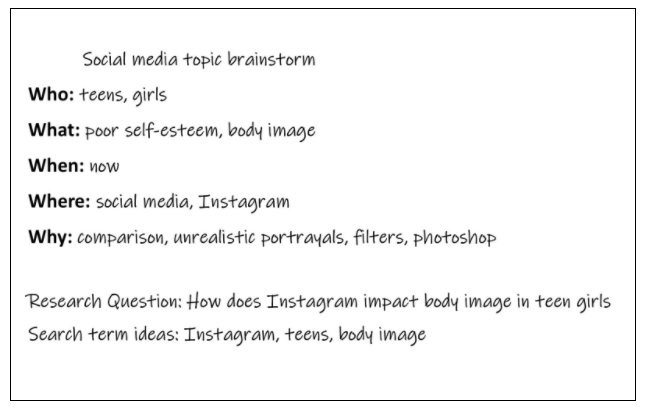9.2: Beginning Your Research
- Page ID
- 110142
Research is a daily part of our lives. Even when performing a simple Google search, you have a question, determine what sort of information you need, decide where to go to find that information and select sources that you feel are the best to answer the question. All of these aspects are part of research. You will be using the same skill set for your research projects in college.
When your professor assigns you a research project, the first thing you want to do is carefully review the assignment. What are the requirements of this project? Pay attention to how many sources you will need as well as what types of sources are required. Next, you need to choose a topic. Thinking of a suitable topic sometimes can be difficult. You want to select a topic that is interesting to you, relevant to the assignment, realistic for the length of the assignment and focused.
Many times when a student first chooses a research topic, the topic is too broad for an effective search. For example, Jenn decides on the research topic “the effects of social media.” When she searches for her topic, she sees thousands of articles and is completely overwhelmed. Jenn struggles to find relevant results because her topic is not specific. Her search for “effects'' of social media will bring up results covering all the positive as well as negative effects of social media on everything from the impact on children to the benefits of business. Jenn knows she can't cover all of those topics in just a three-page paper. She needs to spend a few minutes narrowing her topic.
You will know your topic is too broad when the topic can be summarized in one or two words such as “gun control,” “immigration” or “social media.” A topic that is too broad will be difficult and overwhelming to search. If you are struggling with narrowing a topic, a who/what/when/where/why brainstorming technique where you consider the following questions can be helpful. Jotting down several different ideas is okay because this process is just a brainstorm.
I am selecting this topic to better understand...
Who?
On whom are you focusing? Children, teens, a particular group, specific population, men, women, etc.?
What?
On what aspect are you focusing? Is there a particular issue or theory?
When?
On what time frame are you focusing? What’s currently going on? Something historical? A particular time frame or period in life?
Where?
Are you focusing on a particular region, country or location such as college, inner city, etc.?
Why?
Why is this topic important? Why are you interested?



